What do you do on a 22,000 acre cattle ranch in Wyoming for a month? You make a whole lot of art. I just spent the month of April at an artist residency at the Ucross Foundation in northern Wyoming. There is no way to describe how wonderful of an experience it was in a few short sentences, so you’ll just have to take my word for it.
My mission…create a body of work depicting vultures in a beautiful way. I love a challenge and I’ve always enjoyed finding beauty in what others might consider “filthy”. (I am a dirtbag at heart).
This series is comprised of five 40”x30” oil on canvas paintings and nine 12”x9” pastel and charcoal drawings on butcherpaper. All of the vultures in the paintings are listed by the IUCN Red List of Threatened Species as vulnerable, endangered, or critically endangered.
It is my hope that the viewer can catch a glimpse of how beautiful I see these wonderful creatures and understand that they are valuable within our communities and beyond.
(You can find more information and great photos of the vultures below by visiting arkive.org and iucnredlist.org).
Sunday, May 2, 2010
Beauty and the Butterfly Paintings
 Beauty and the Butterfly Painting Series
Beauty and the Butterfly Painting Series Cape Vulture
Cape Vulture (also known as Cape Griffon)
 California Condor
California Condor White-headed Vulture
White-headed VultureSeeing a California condor with my own eyes made this project a priority. This particular condor was recovering from a serious bout of lead poisoning which she acquired by eating carrion shot with lead bullets.
Her wingspan is 9.5 ft., making her 10 ft. wide flight enclosure a tight squeeze! I had the privilege of watching as she was moved to this enclosure. She was cautious and so inquisitive. As she investigated her new surroundings, you could see her “wheels turning”. What a smart and beautiful girl. I am glad to say that she is well and on her way to being released back into her natural habitat.
Vultures don’t fall into what the masses consider beautiful and maybe that is why I adore them. It is my hope that this series will allow the viewer to see them in a different light.
Her wingspan is 9.5 ft., making her 10 ft. wide flight enclosure a tight squeeze! I had the privilege of watching as she was moved to this enclosure. She was cautious and so inquisitive. As she investigated her new surroundings, you could see her “wheels turning”. What a smart and beautiful girl. I am glad to say that she is well and on her way to being released back into her natural habitat.
Vultures don’t fall into what the masses consider beautiful and maybe that is why I adore them. It is my hope that this series will allow the viewer to see them in a different light.
Saturday, April 3, 2010
Wishes For Wildlife
 Liberty Wildlife's 17th Annual Wishes for Wildlife Benefit Event
Liberty Wildlife's 17th Annual Wishes for Wildlife Benefit EventSATURDAY APRIL 17, 2010 AT 6:00PM
FAIRMONT SCOTTSDALE RESORT
FOR TICKET INFORMATION VISIT http://www.wishesforwildlife.org/
5 Burrowing Owls is one of the auction items that will be available on the evening of the event. Help support our wildlife!
Tuesday, January 12, 2010
The Dodo, Passenger Pigeon, and Great Auk are three birds that everyone on this planet should know about. Unfortunately, we can only read about them because all three are extinct and we were the sole cause. One of my favorite bird books is The Great Book of Birds by John Gooders. Below are words taken from Mr. Gooders about these lost treasures.
Dodo is a classic. This giant flightless pigeon was first discovered in 1599 and thereafter was hunted for food by mariners. By 1681 they were extinct. (That’s less than 100 years!!)
Perhaps no story of man’s senseless slaughter matches that of the extermination of the Passenger Pigeon. No doubt when the first white men arrived in American, the Passenger Pigeon was the most numerous bird on earth. Breeding colonies could often be measured in miles. By the middle of the 19th century thousands of hunters earned their living from shooting the birds. Within a couple of generations the flocks were no more. Martha, the last captive female died in Cincinnati Zoo in 1914.
The Great Auk of the North Atlantic was exterminated by sailors in 1844. This flightless, 30 inch bird was the northern equivalent of the penguins. It was a welcome item of food to scurvy-ridden sailors on long voyages.
Education and compassion are the only things that can keep this from happening in the future.
Dodo is a classic. This giant flightless pigeon was first discovered in 1599 and thereafter was hunted for food by mariners. By 1681 they were extinct. (That’s less than 100 years!!)
Perhaps no story of man’s senseless slaughter matches that of the extermination of the Passenger Pigeon. No doubt when the first white men arrived in American, the Passenger Pigeon was the most numerous bird on earth. Breeding colonies could often be measured in miles. By the middle of the 19th century thousands of hunters earned their living from shooting the birds. Within a couple of generations the flocks were no more. Martha, the last captive female died in Cincinnati Zoo in 1914.
The Great Auk of the North Atlantic was exterminated by sailors in 1844. This flightless, 30 inch bird was the northern equivalent of the penguins. It was a welcome item of food to scurvy-ridden sailors on long voyages.
Education and compassion are the only things that can keep this from happening in the future.
Subscribe to:
Comments (Atom)















